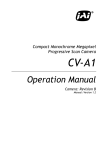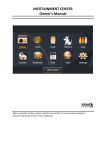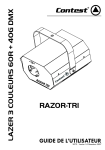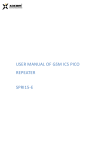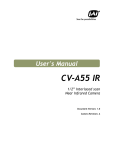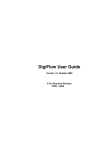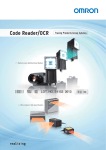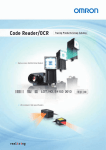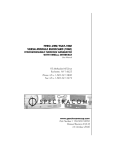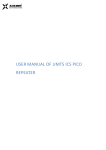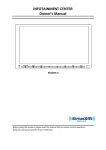Download User`s Manual
Transcript
Industrial Monochrome CCD Camera CV-A50 IR Operation Manual Revision 0 Manual: Version- 1.0 A50Manualnov25.doc JPT 25-11-03 CV-A50 IR DECLARATION OF CONFORMITY AS DEFINED BY THE COUNCIL DIRECTIVE 89/336/EEC EMC (ELECTROMAGNETIC COMPABILITY) WE HEREWITH DECLARE THAT THIS PRODUCT COMPLIES WITH THE FOLOWING PROVISIONS APPLYING TO IT. EN 61000-6-2 EN 61000-6-3 Table of Contents 1. General......................................................................................................... 2 2. Standard Composition ....................................................................................... 2 3. Main Features ................................................................................................. 2 4. Camera Housing and Dimensions........................................................................... 3 5. Pin Assignment................................................................................................ 4 5.1. 12-pin Multi-connector (DC-IN/VIDEO OUT, EXT.HD/VD IN) ............................................... 4 5.2. 6-pin Multi-connector (TRIGGER and RS232C) ................................................................ 4 5.3. Input and Output Circuits........................................................................................ 5 5.3.1. Video output................................................................................................ 5 5.3.2. Trigger input................................................................................................ 5 5.3.3. HD and VD input............................................................................................ 5 5.3.4. HD, VD, PCLK, WEN and EEN output .................................................................... 5 6. Functions and Operations ................................................................................... 6 6.1. Basic functions .................................................................................................... 6 6.2. Input-output of HD/VD Signals.................................................................................. 7 6.3. Continuous Operation (Non triggered)......................................................................... 7 6.4. External Trigger Modes..........................................................................................11 6.5. Edge Pre-select Mode ...........................................................................................12 6.6. Pulse Width Control Mode ......................................................................................13 6.7. Frame-delay read out Mode ....................................................................................14 6.8. Long Time Exposure Mode ......................................................................................15 6.9. Start/Stop Mode..................................................................................................16 6.10. Other Functions.................................................................................................17 7. Configuring the Camera ................................................................................... 18 7.1. RS-232C control. .................................................................................................18 7.2. CV-A50 IR RS-232C command list. .............................................................................19 7.3. Camera Control Tool for CV-A50/60 ..........................................................................20 7.4.1 HD/VD input-output selection ...........................................................................21 7.4.2. Selecting termination of HD/VD input signals........................................................21 8. Specifications ............................................................................................... 22 9. Spectral Sensitivity......................................................................................... 23 10. Appendix ................................................................................................... 23 10.1. CV-A50 IR emulating CV-M50 IR interfacing ................................................................23 10.2. WEN out on pin 6 on 6 pin connector .......................................................................24 10.3. CV-A50 IR without sync on video output. ...................................................................24 10.4. Precautions ......................................................................................................25 10.5. Typical CCD Characteristics...................................................................................25 11. Users Record ............................................................................................... 26 -1- CV-A50 IR 1. General The CV-A50 IR is a monochrome CCIR and EIA interlaced 1/2” CCD cameras with enhanced near IR response, designed for a wide range of automated imaging application. The camera features a compact housing and a wide range of unique functions. The asynchronous trigger can be set to work in several modes, to allow functions such as pulse width controlled shutter, programmable shutter speed and long time integration. All mode settings of the camera can be set up via an RS-232C interface, greatly reducing the need for mechanical switches of jumpers. The CV-A50 IR outputs an analogue video signal, with composite sync. The latest version of this manual can be downloaded from: www.jai.com The latest version of Camera Control Tool for CV-A50IR (CV-A50/60) can be downloaded from: www.jai.com 2. Standard Composition The standard camera composition consists of the camera main body and C-mount protection cap. 3. Main Features • • • • • • • • • • • • • • • Compact size 1/2” monochrome near IR CCD camera 752 (h) x 582 (v) pixels for CCIR, 768 (h) x 494 (v) for EIA Improved sensitivity, dynamic range and smear performance High S/N ratio > 59dB Extended range of functions and options compared to CV-M50 IR Interlaced or non-interlaced scanning. Field or frame accumulation. Internal, external HD/VD or random synchronization Edge pre-select, pulse width and start/stop trigger modes Long time exposure with external VD pulse Frame delay readout mode Exposure enable EEN, write enable WEN and pixel clock out No mechanical switches or jumpers for mode setting Short ASCII commands for modes setting via serial port Shutter speed down to 1/10,000 in 8 steps Windows NT/2000/XP setup software -2- CV-A50 IR 4. Camera Housing and Dimensions Fig. 1. Locations and dimensions. 1. 2. 3. 4. 5. 6. 7. Note *1): 12-pin Hirose connector for frame grabber interfacing and power (12V DC). BNC connector for video output. VS 1.0 Vpp 75 Ohm. 6-pin Hirose connector for trigger input and RS-232C control interface. Gain potentiometer for manual gain setting. Mounting holes, 8 x M3. For precision mounting use only the 4 holes located at the forward part of the bottom plate. 1/2” interline-transfer type CCD sensor. Lens mount for C-mount lenses. *1) Rear protrusion on the C-mount lens must be less than 10mm (0.4 inches approx.). When IR-cut filter is used, it must be less than 7.0 mm (0.28 inches approx.). The IR-cut filter is placed in the C-mount thread. The C-mount IR-cut filter must be ordered separately. -3- CV-A50 IR 5. Pin Assignment 5.1. 12-pin Multi-connector (DC-IN/VIDEO OUT, EXT.HD/VD IN) Type: HR10A-10R-12PB-01 (Hirose) male Seen from rear. 9 1 2 4 8 10 11 3 Pin configuration is compatible with EIAJ standard 7 12 5 6 Pin no. 1 2 3 4 5 6 7 8 9 10 11 12 Signal GND +12 V DC input GND Video output GND HD input/HD output VD input/VD output GND Pixel clock output WEN output Trigger input GND Remarks Parallel with the BNC connector. *) SW2.1 on for 75Ω. SW1.1 on for HD out. *) SW2.2 on for75Ω. SW1.2 on for VD out. *) JP2 short and PC=1 for pclk out. *) *2) GND if JP5 open and JP3 short *) +12V DC if JP1 short and JP4 open Fig. 2. 12-pin connector. Plugs for cable: HR10A-10P-12S 5.2. 6-pin Multi-connector (TRIGGER and RS232C) Type: HR10A-7R-6PB (Hirose) male Seen from rear. 1 6 3 4 2 5 Pin no. 1 2 3 4 5 6 Signal TXD out RXD in GND GND Trigger input EEN output Remarks RS-232C RS-232C *) Parallel with pin 11 on 12 pin con *) *3) WEN out refer to chapter 10.2. Fig. 3. 6-pin connector. Plugs for cable: HR10A-7P-6S Notes: *) *2) *3) Alternative signals can be placed on these pins by switch or jumper settings or RS-232C commands. Refer to chapter 10.1. and 10.2. for alternative signals. Configurations shown in Bold + italic is factory setting. WEN (Write Enable) pulse indicates the period of effective video signal output. It is usefull for setting the timing with framegrabber. EEN (Exposure Enable) pulse indicates the duration of the shutter, and can be used for controlling strobe illumination. EEN will be low all the time in normal continous mode (TR=0), if the selected exposure time is longer than the video readout time. For schematic diagram of the input and output circuit with alternative settings refer to 5.3. -4- CV-A50 IR 5.3. Input and Output Circuits In the following schematic diagrams the input and output circuits for video and timing signals are shown. Jumper settings are shown as for factory default. For alternative connections refer to “10.1. CV-A50 IR emulating CV-M50 IR interfacing.” 5.3.1. Video output The video output is a 75 Ω DC coupled circuit. The BNC connector and pin #4 on the 12-pin connector is in parallel. Avoid double termination. The video DC level is shown with 75 Ω termination. #4/12 CXA1310 L 2μ7 75 82p NC 32 Video Output 300 mV BNC 420 mV GND Fig. 4. Video output. 5.3.2. Trigger input +12v The trigger input is AC coupled. To allow a JP1 long pulse width, the input circuit is a flip 100 #11/12 JP4 Trigger flop, which is toggled by the negative or 100n input positive differentiated spikes caused by 100n #5/6 the falling or rising trigger edges. The trigger polarity can be changed. NC NC Trigger input level 4 V ±2 V. The trigger-input impedance is 1 kΩ. GND JP1 and JP4 are for alternative configuration for pin #10. Fig. 5. Trigger input. 5.3.3. HD and VD input The input circuit for external HD and VD signals are shown. It can be 75 Ω terminated by closing SW2. SW1 will switch to output the internal HD and VD signal. HD and VD input level is 4 V ±2 V. +5V 33k 1k TTL 33k 100k 1k 1n GND From VD HD output +5V 33k + VD HD Input/output NC 10μ 1k2 SW1 1k 1n TTL 47p 75 SW2 4k7 GND Fig. 6. HD and VD input. 5.3.4. HD, VD, PCLK, WEN and EEN output Output circuit for these signals are 75 Ω complementary emitter followers. It will deliver a full TTL signal. JP5 and JP3 are for alternative configuration for pin #10. Output level ≥4 V from 75Ω. (No termination). The WEN polarity can be changed. +5V 10k TTL VD, HD 220 10 67 WEN/ EEN 10 PCLK SW1 #6/6 JP2 #9/12 WEN 10k Fig. 7. HD, VD, PCLK, WEN and EEN output. -5- JP5 #10/12 JP3 GND CV-A50 IR 6. Functions and Operations Apart from the standard continuous operation, the CV-A50 IR features three external asynchronous trigger modes (edge pre-select, pulse width controlled and start/stop) and a special frame-delay readout mode. Long integration time mode is also supported. 6.1. Basic functions Some of the primary camera functions need a general introduction before the operation modes are described. The list below shows the primary functions from the command list. SM SH PE SC TR Shutter Mode Shutter Speed Programmable Exposure Scanning Format Trigger Mode FR Accumulation Normal shutter, Programmable Exposure Off to 1/10,000 second 1.5 H to 1023.5 H Interlaced, non-interlaced, (1/2 partial, 1/3 partial) Normal, Edge, PWC, frame delay readout Long time exposure, start-stop Field, Frame The shutter SM can be set to normal (SM=0), where the exposure time is selected from 8 fixed step with the command SH, or programmable exposure (SM=1). Here the command PE allows up to 1023 steps with 1 period resolution (64 μs) for edge pre-select mode. For normal modes PE can be up to 312 for CCIR and 262 for EIA. The scanning format SC can be selected between interlaced and non-interlaced sync signals. Further it is possible to select 1/2 and 1/3 partial scanning. It is not supported for the camera. The accumulation FR can be field or frame. Fig. 9. shows details for frame and field accumulation with shutter OFF, (left(, and shutter on, (right). The accumulation in all trigger modes is H synchronous. The exposure will start at the first HD pulse after the trigger falling edge. Fig. 8. shows the details. In all triggered shutter modes, the shortest shutter time is limited to ≥1.5 H or 1/10,000. In trigger modes, the exposure time is not limited to the readout time. It can be longer. HD Trigger Accum b Fig. 8. PWC H synchronous accumulation. Time Frame accum. Photo charge Photo charge t2 t3 t4 Time Frame accum. Photo charge Field 1 Field 2 E t1 t2 t3 VD Xsg1 Xsg2 Field 1 Field 2 O Interlaced Field accum. Photo charge Field 1 Field 2 Interlaced t0 Video out Interlaced Xsg Video out Sync t1 VD Xsg1 Xsg2 Video out Field accum. t0 E E Sync Interlaced Non-interlaced E E Fig. 9. Frame and field accumulation without shutter (left) and with shutter (right). -6- O Field 1 Field 2 Video out O E E Xsg O E t4 CV-A50 IR 6.2. Input-output of HD/VD Signals In the default setting the camera will accept external HD/VD signals on pin 6 and 7 of the 12 pin Hirose connector. If external HD/VD is applied, the camera will synchronize to it. If no external sync signals are applied, the camera will operate with its internal x-tal controlled sync. The time requirements to the relation between VD and HD are shown in fig. 16. The input is TTL level as factory setting. It can be 75 Ohm terminated by the internal switch on the PK8277 board. SW2-1 for HD and SW2-2 for VD. On for 75 Ohm termination. To output the internal HD/VD signals on pin 6 and 7 the internal switch SW1-1 and 1-2 on the PK8277 board should be set ON. The output is TTL level from a 75-Ohm source. Refer to “7.4. Internal Switch and Jumper settings.” In trigger modes the internal VD will be reset and restarted after the triggered exposure. It will continuous until next trigger. To use this mode: Set function: Input: SW 1 on PK8277 to IN for external VD/HD input. Factory default. SW 2 on PK8277 to 75 Ω for termination of VD/HD. SW 2 on PK8277 to TTL for TTL level for VD/HD. Factory defaults. SW 1 on PK8277 to OUT for internal VD/HD output. Ext. VD in or int. VD out on pin 7 on 12-pin connector. Ext. HD in or int. HD out on pin 6 on 12-pin connector. Important notes on using this mode External sync system should follow the camera scanning system. 6.3. Continuous Operation (Non triggered) For applications that do not require asynchronous external trigger (continuous operation). This is the factory default setting of the camera. To use this mode: Set function: Input: Trigger mode to “Normal” Shutter mode “Normal” or “Programmable” “Shutter Speed” “Programmable exposure” for CCIR “Programmable exposure” for EIA Polarity and other functions Ext. VD on pin 7 on 12-pin connector. If used. Ext. HD on pin 6 on 12-pin connector. If used. TR=0 SM=0, SM=1 SH=0 through 7 PE=1 through 312 PE=1 through 262 Important notes on using this mode Fig. 10 through fig.13A on the following pages shows horizontal and vertical timing details for CCIR and EIA interlaced and non-interlaced. -7- CV-A50 IR Fig. 10. Horizontal timing details and pixel numbering for the CCD array. CCIR Fig. 11. Horizontal timing details and pixel numbering for the CCD array. EIA -8- CV-A50 IR Fig. 12. Vertical timing details for interlaced. CCIR Fig. 12A. Vertical timing details for non-interlaced. CCIR -9- CV-A50 IR Fig. 13. Vertical timing details for interlaced. EIA Fig. 13A. Vertical timing details for non-interlaced. EIA - 10 - CV-A50 IR 6.4. External Trigger Modes This camera has 5 external asynchronous trigger modes, which can be set by RS-232C commands. 1. 2. 3. 4. 5. Edge Pre-select Mode.TR=1 Pulse Width Control Mode. TR=2 Frame Delay read out mode. TR=3 Long Time Exposure Mode. TR=4 Start/stop Mode. TR=5 Pre-selected exposure. (SM=0, SM=1) Pulse width controlled exposure. PWC exposure read out by ext. VD. Exposure is interval between ext. VD. Exposure start by trigger and stop by ext. VD An external trigger pulse initiates the capture (input on pin 11 of the 12-pin Hirose connector or pin 5 of the 6-pin Hirose). The leading edge of the trigger pulse initiates the exposure (this is a falling edge if factory default) and the duration of the pulse governs the exposure (accumulation) time. If the polarity of this pulse is reversed, the camera can be configured to correct for it. The duration of the external trigger pulse must be greater than 1H. It is recommended to make this longer, typically 9H. Important notes on using trigger modes:The accumulation is HD synchronously accumulation. The accumulation starts at the first HD after the trigger leading edge. Shown in fig. 15. To avoid the <1H jitter caused by this delay, synchronize the external trigger to HD as shown in fig. 14. The trigger level translations should be placed inside the time A, which is 8 μseconds. Do not input a new trigger before the previous video is read out. (WEN is high). A=8 µsec A=8μsec Fig. 14. Trigger/HD timing. t1 t2 t3 t4 t5 HD Trigger Note: Xsg and Xsub are internal signals in the camera. They are shown in the timing diagram for better understanding. Accum Xsub Xsg EEN Fig. 15. Pulse Width H synchronous accumulation. Fig. 16. Ext. HD and ext. VD phase conditions. - 11 - CV-A50 IR 6.5. Edge Pre-select Mode The leading edge of the trigger pulse initiates the exposure. The exposure time (accumulation time) is governed by the pre-defined shutter speed set by RS-232C. The resulting video is output as “odd field” for EIA and “even field” for CCIR, and appear 9H (EIA9 or 10H (CCIR) after the leading edge of WEN (polarity is user selectable). To use this mode: Set function: Input: Trigger mode to “Edge Pre-select” TR=1 Accumulation to “Field” FR=0 Scanning to “Non-interlaced” SC=1 Shutter mode to “Normal” or “Programmable” SM=0, SM=1 Shutter Speed SH=0 through 7 or Programmable exposure PE=1 through 1023 Polarity for trigger and other functions Ext. trigger to pin 5 on 6 pin connector (or pin 11 on 12-pin connector). Ext. HD to pin 6 on12-pin connector. (If used). Fig. 17. Edge pre-select CCIR Fig. 18. Edge pre-select EIA Important notes on using this mode:• The duration of the external trigger pulse must be greater than 1H. It is recommended to make this longer, typically 9H. • Do not input external VD signal at Pin No. 7 of the 12-pin Hirose connector, as it may disturb the external trigger function. - 12 - CV-A50 IR 6.6. Pulse Width Control Mode The leading edge of the trigger pulse initiates the exposure. The exposure time (accumulation time) is governed by duration of the trigger pulse. The resulting video is output as “odd field” for EIA and “even field” for CCIR, and appear 9H (EIA9 or 10H (CCIR) after the leading edge of WEN (polarity is user selectable). The exposure time range is 1.5H to 1000H (shortest and longest pulse duration). To use this mode: Set function: Input: Trigger mode to “Pulse Width Control” TR=2 Accumulation to “Field” FR=0 Scanning to “Non-interlaced” SC=1 Polarity and other functions Ext. trigger to pin 5 on 6 pin connector (or pin 11 on 12 pin connector). Ext HD to pin 6 on 12 pin connector. (If used) Fig. 19. Pulse width control CCIR. Fig. 20. Pulse width control EIA. Important notes on using this mode:• Do not input external VD signal at Pin No. 7 of the 12-pin Hirose connector, as it may disturb the external trigger function. - 13 - CV-A50 IR 6.7. Frame-delay read out Mode This mode allows simultaneous capture of multiple camera using a common external trigger pulse subsequent multiplexed (sequential) readout using a single input frame grabber, as the user has control over when the image is read out from the CCD sensor. The exposure starts at the falling edge of the ext. trigger signal, and ends at the rising edge of the ext. trigger signal. (In the same way as Pulse Width Control mode). The captured image is now stored in the CCD until an ext. VD signal is given to the camera. The resulting video is output as “odd field” for EIA and “even field” for CCIR, and appear 9H (EIA9 or 10H (CCIR) after the leading edge of WEN (polarity is user selectable). To use this mode: Set function: Trigger mode to “Frame delay read-out” TR=3 Accumulation to “Field” FR=0 Scanning to “Non-interlaced” SC=1 Polarity and other functions Input: Ext. trigger to pin 5 on 6 pin connector (or pin 11 on 12 pin connector). Ext. VD to pin 7 on 12 pin connector. Ext HD to pin 6 on 12 pin connector. (If used) Fig. 21. Frame delay read-out. CCIR Fig. 22. Frame delay read out. EIA Important notes on using this mode:• The readout delay time must not exceed 2 seconds. This is because visible dark current noise may appear on the video signal due to the long time exposure of the CCD image sensor. • It is recommended to use a strobe light (e.g. LEDs or Xenon tube. High light levels during the delay time can disturb the image. The EEN signal can be used to trigger a strobe light • See Fig. 16 for the phase relationship between ext. HD and ext. VD pulses. - 14 - CV-A50 IR 6.8. Long Time Exposure Mode The exposure time is the interval between 2 ext. VD pulses sent to the VD input of the camera (Pin No. 7 of the 12-pin Hirose connector). The exposure starts after input of the first ext. VD pulse, and ends after the next input of the next ext. VD pulse, which again starts a new exposure. The long time exposure is a continuous process where each external VD will synchronize the camera, stop on exposure, start a new exposure and read out the previous accumulated signal. The exposure time can be selected in intervals of complete vertical timing periods (525H for EIA and 625H for CCIR). To use this mode: Set function: Input: Trigger mode to “Long time exposure” Accumulation to “Field” or “Frame” Scanning to “Interlaced” Shutter to “OFF” Polarity and other functions Ext. VD to pin 7 on 12 pin connector. Ext HD to pin 6 on 12 pin connector. TR=4 FR=0, F=1 SC=0 SH=0 Fig. 23. Long time exposure. Field accumulation. Fig. 24. Long time exposure. Frame accumulation. Important notes on using this mode:• Exposure time range is 1/30 sec. to ∞. However, it is recommended not to use exposure over 2.0 sec. This is because visible dark current noise may appear on the video signal due to the long time exposure of the CCD image sensor. • Ext. HD signal (TTL 2.0~5.0V) has to be input continuously. • See Fig. 16 for the phase relationship between ext. HD and ext. VD pulses • The EEN pulse is not provided when using this mode. - 15 - CV-A50 IR 6.9. Start/Stop Mode The exposure time is controlled by the interval between the ext. trigger and the ext. VD signal. The exposure starts at the first HD pulse after the falling edge of the ext. trigger, and stops 14.5 H after the falling edge of the VD pulse. It means that the trigger pulse must be applied after the external VD pulse, for exposures less than 14.5 H. The range can be between 1/60 to 1/10,000 for EIA, and 1/50 to 1/10,000 for CCIR. The Start/Stop mode is a continuous mode where the VD signal must be given continuously. It is not possible to input external VD randomly. The difference between interlaced frame accumulation or field accumulation can be explained as follow. Both modes have 2 fields output in an interlaced frame. With frame accumulation, the contents in the ODD and EVEN sync fields will come from sensing field 1 and 2 on the CCD sensor. With field accumulation both ODD and EVEN sync fields will contain the signal from sensing field 1 and 2 added together. Non-interlaced with field accumulation needs only 1 trigger pulse for each field. To use this mode: Set function: Input: Trigger mode to “Start/Stop” Accumulation to “Field” or “Frame” Scanning to “Interlaced” Polarity and other functions Ext. VD to pin 7 on 12 pin connector. Ext HD to pin 6 on 12 pin connector. TR=5 FR=0, F=1 SC=0 Fig. 25a. Start/stop mode. Interlaced with frame accumulation. Fig. 25b. Start/stop mode. Interlaced with field accumulation. ext. Trig 13H ext. H D ext. V D accum ulation stops here Accum M in. accum . com posite video Fig. 26. Start/Stop timing details. - 16 - CV-A50 IR Important notes on using this mode:• As the start of exposure will be synchronized with the internal H signal, the start of exposure may be shifted by max 1H. • To avoid this shift (jitter), synchronize the camera with an external HD and make sure that the trigger pulse aligns to the HD signal as shown in Fig. 14. • For exposures <14 H, the trigger pulse is after the extern VD pulse. Fig. 26 6.10. Other Functions Gain and analogue settings. !! Do not adjust these settings unless you have knowledge of video adjustments !! AS, AGC Switch The video gain can be set to AGC or manual. In AGC mode the video level is kept constant by the automatic gain control circuit within a 12 dB range. Normal 700 mVpp ±30 mV. The level can be adjusted with AG, AGC level in the range 0 to 255. RP, Rear Potentiometer In manual gain mode, the gain level can be adjusted by the rear potentiometer, or it can be adjusted by GA, Manual Gain level in the range 0 to 255. SU, Setup level. This setting can adjust the setup level (or black level). Normal 20 mVpp ±2 mv. WC, White clip level. To adjusting the wanted white clip level. Normal 800 mVpp ±30 mv. GA, Gamma select. Gamma can be 1 (linear) or 0.45. Signal and Polarity. PC, Pixel clock on/off. Set to on if the pixel clock is used. Note that jumper JP2 on rear board PK8274 should be closed. (factory setting). Refer to chapter 10.2. for position. To avoid interference the pixel clock out should be off when the pixel clock is not used. TP, Trigger polarity. Will invert the trigger-input signal. WP, WEN polarity. Will invert the WEN output signal. - 17 - CV-A50 IR 7. Configuring the Camera 7.1. RS-232C control. All configuration of the A50/60 camera is done via the RS-232C port. The camera can be set up from a PC running terminal emulator software, or using JAI´s camera control software. Below is the description of the ASCII based short command protocol. Communication setting. Baud Rate Data Length Start Bit Stop Bit Parity Xon/Xoff Control 9600 bps 8 bit 1 bit 1 bit None None RS 232C cable TXD CAMERA RXD GND 1 4 6 2 3 5 7 8 9 CD DTR DSR RXD TXD GND RTS CTS CI 9 pin D-con PC COM PORT Fig. 27. RS-232C cable. Protocol. Transmit setting to camera: NN=[Parameter]<CR><LF> (NN is any kind of command. Capital or small letters.) To have all communication visible on the emulator screen, start with: EB=1<CR><LF> The camera answers: COMPLETE<CR><LF> Transmit the following to see the current parameter for a command: NN?<CR><LF> (NN is any commands with parameters.) The camera answers: NN=[Parameter] Transmit the following to see the camera current settings: ST?<CR><LF> The camera returns the current parameter settings, firmware and camera type and number. Transmit the following to get command list help: HP?<CR><LF> The camera returns a complete command list. Unknown commands send to camera: (XY is unknown command). XY=1<CR><LF> The camera answers: 01 Unknown Command!!<CR><LF> Invalid parameters send to camera: (99 is invalid parameter for SH). SH=99<CR><LF> The camera answers: 02 Bad Parameters!!<CR><LF> - 18 - CV-A50 IR 7.2. CV-A50 IR RS-232C command list. EB ST HP VN SC Command Name Format A – General settings and useful commands Echo Back EB=[Param.]<CR><LF> Camera Status request ST?<CR><LF> Online Help request HP?<CR><LF> Firmware version VN?<CR><LF> B – Timing and shutter related commands Scanning format SC=[Param.]<CR><LF> Parameter 0=Echo off Remarks 1=Echo on Off at power up Actual setting Command list 3 letter version 0=Interlaced 2=1/2 partial 0=normal 2=Pulse width 4=Long time 0=Normal 0=Off 1=Non-interl. 3=1/3 partial 1=Edge 3=Frame delay 5=Start/stop 1=Programmab. 1=1/100 0=1/50 (1/60) 2=1/250 4=1/1000 6=1/4000 0= No function 1023=1023.5H 1=1/125 3=1/500 5=1/2000 7=1/10000 1=1.5H 0=Field 0=no clock out 1=Frame 1=clock out Trigger polarity TP=[Param.]<CR><LF> WEN polarity WP=[Param.]<CR><LF> D – Gain and analogue signals setting AS AGC Switch AS=[Param.]<CR><LF> AG AGC Level AG=[Param.]<CR><LF> GA Manual gain Level GA=[Param.]<CR><LF> RP Rear Potentiometer RP=[Param.]<CR><LF> SU Setup Level SU=[Param.]<CR><LF> WC White clip Level WC=[Param.]<CR><LF> GS Gamma Select GS=[Param.]<CR><LF> E – Saving and loading data in EEPROM LD Load settings from LD=[Param.]<CR><LF> camera EEPROM 0= active low 0= active low 1= active high 1= active high 0=AGC off 0=low 0=low 0=manual gain 0=low 0=low 0=gamma 1 1=AGC on 255=high 255=high 1=rear potm. 255=high 255=high 1=gamma 0.45 0= manual gain 0=Factory data 2=User 2 area 1=User 1 area 3=User 3 area Latest used data area becomes default at next power up SA 1=User 1 area 3=User 3 area 2=User 2 area TR Trigger mode TR=[Param.]<CR><LF> SM SH Shutter mode Shutter speed SM=[Param.]<CR><LF> SH=[Param.]<CR><LF> PE Programmable expos. PE=[Param.]<CR><LF> FR PC C – Signals and polarity Accumulation Pixel clock FR=[Param.]<CR><LF> PC=[Param.]<CR><LF> TP WP EA *1) *2) !! Save settings to camera EEPROM EEPROM area request SA=[Param.]<CR><LF> EA?<CR><LF> Partial scanning is not supported Continuous only Trigger modes and Continuous CCIR. H=64μsec EIA, H=63.5μsec *1) Should be off when not used *2) Range 0 to 255 Range 0 to 255 Range 0 to 255 Range 0 to 255 Return latest used area In normal non trigger mode (TR=0) PE<312 for CCIR and PE<262 for EIA. In trigger mode TR=1, EEN will not be correct if PE>833. If positive logic is used (TP=1), the first trigger pulse after power up will be ignored. Do not try to use commands not shown in the list. - 19 - CV-A50 IR 7.3. Camera Control Tool for CV-A50 IR (CV-A50/60 software) From www.jai.com CV-A50/60 Camera Control Tool for Windows 98/NT/2000 can be downloaded. The control tool contents a camera control program and tools for making your own program. Below the different windows are shown. Control bar Windows for all functions Fig. 28. Windows from Camera Tools. For the integrator and experienced user, the Camera Control Toll is much more than a program with a window interface. It also provides an easy and efficient ActiveX interface built for MS Windows 98, ME, NT and 2000. The OCX interface has the ability to connect to the camera using the serial interface of the PC by reading and writing properties for the camera. This integration requires simple programming skills within Visual Basic, Visual C++ or similar languages in a Microsoft Windows environment. - 20 - CV-A50 IR 7.4. Internal Switch and Jumper Settings. 7.4.1 HD/VD input-output selection In the default setting the camera will accept external HD/VD signals on pins 6 and 7 of the 12 pin Hirose connector. The composite video signal from the camera will be synchronized to an external HD/VD source connected to the camera. TTL level (between 2 and 5 V). To set up the camera to output HD/VD signals on pins 6 and 7 on the Hirose connector follow these steps. See fig. 29. 1. Switch off the power to the camera. 2. Remove the camera cover, by removing the 5 screws. 3. Locate switches SW1-1 and SW1-2 on the PK8277 circuit board, and set both in the ON position. Note: The HD/VD output source is 75 Ohm. 7.4.2. Selecting termination of HD/VD input signals The default setting of the HD/VD input is high impedance TTL. The camera expects to get a signal that swings between 2 and 5 volts. This setting allows the largest number of camera to be synchronized from a single HD/VD source (such as another camera or a frame grabber). Under certain circumstances it may be necessary to terminate the HD/VD input, in order to match the impedance of the signal source, to eliminate over/undershoot or standing waves in the signal. To change the HD/VD input to 75Ohm terminated, follow these steps 1. Switch off the power to the camera. 2. Remove the camera cover, by removing the 6 screws. 3. Locate switches SW2-1 and SW2-2 on the PK8277 circuit board, and set the according both in the ON position. Int. HD/VD out 75 Ω terminated Ext. HD/VD in (factory set) TTL (factory set) Fig. 29. HD/VD switch positions on PK8277 board. - 21 - CV-A50 IR 8. Specifications Specifications CV-A50 IR C Scanning system CV-A50 IR E CCIR, 25 frames/sec. EIA. 30 frames/sec. 625 lines, 2:1 Interlaced 525 lines, 2:1 Interlaced Frame rate (Full frame) 50 Hz 59.94 Hz Line frequency 15.625 kHz 15.734 kHz Pixel frequency 14.1875 MHz 14.3182 MHz CCD sensor 1/2”. CV-A50 Monochr. IT CCD. ICX-429ALL Monochr. IT CCD. ICX428ALL Sensing area 6.4 (h) x 4.8 (v) mm Effective pixels 752 (h) x 582 (v) 768 (h) x 494 (v) Pixels in video output 737 (h) x 575 (v) 758 (h) x 486 (v) Cell size 1/2”. CV-A50 8.6 (h) x 8.3 (v) µm 8.4 (h) x 9.8 (v) µm Resolution horizontal 570 TV lines Sensitivity on sensor 0.02 Lux, Max gain, 50% video S/N ratio 59 dB 60 dB Video output Composite VS signal, 1.0 Vpp, 75 Ω Gamma 1.0 - 0.45 Gain Manual – Automatic Gain range 0 to +15 dB Accumulation Field – Frame Synchronization Int. X-tal. Ext HD/VD or random trigger Scanning 2:1 interlaced, non-interlaced partial scan 1/2, partial scan 1/3 HD sync. input/output 4 Vpp ±2 V, 75 Ω Trigger input 4 Vpp ±2 V, 75 Ω WEN output (write enable) 4 Vpp ±2 V, 75 Ω EEN output (exposure enable) 4 Vpp ±2 V, 75 Ω Pixel clock output 4 Vpp ±2 V, 75 Ω Shutter (off), 1/100, 1/250, 1/500, 1/1000, 1/2000, 1/4500, 1/10,000 sec. Pulse width control 1.5 H to 1000 H Start/stop 1/77 to 1/10,000 second Long time exposure 1 field to ∞ Programmable exposure 1.5 H to 1023.5 H. In edge pre-select CCIR 1.5 to 312.5 H (EIA 1.5 to 262,5 H) Normal continuous mode Frame delay readout Time from PWC trigger input to ext. VD input Functions controlled by Scanning format, Trigger mode, Shutter speed, Trigger/WEN polarity, RS 232C Accumulation, Shutter mode, Programmable exposure, AGC level, White clip, Setup, Manual gain, AGC/manual gain, Internal/ potentiometer gain set, Gamma, Pixel clock, Commands and internal adjustments. VD input/output, HD input/output Functions controlled by internal DIP switches HD, VD and Trigger 75 Ω termination on/off Operating temperature -5°C to +45°C. Humidity 20 - 80% non-condensing Storage temp./humidity -25°C to 60°C./20% - 90 % Regulations CE (EN61000-6-2 and EN61000-6-3), FCC, RoHS, WEEE Power 12V DC ± 10%. 1.5 W Lens mount C-mount Dimensions 29 x 44 x 66 mm (HxWxD) Weight 150 g - 22 - CV-A50 IR 9. Spectral Sensitivity Fig. 30. Spectral sensitivity. 10. Appendix 10.1. CV-A50 IR emulating CV-M50 IR interfacing The CV-A50 IR has a slightly different pin configuration on the 12-pin Hirose connector, compared to the CV-M50 IR. This new configuration is compliant to the EIA-J standard. This means, however, that the CV-A50 IR is not completely backward compatible with the CVM50 IR, in all cases (depending on the cable configuration). This application note gives detailed instruction on how to change the pin configuration, by changing internal solder jumpers. Please note: Only a qualified electronics technician or engineer should make these changes. Hirose pin # 9 9 10 10 11 11 Function PCLK output enabled No connection WEN output Connected to ground Ext Trigger input +12V DC in JP2 Short Open JP3 JP5 JP1 JP4 Remarks Note 2 Open Short Short Open Open Short Note : Configuration shown in Bold+Italic is factory default setting Note 2: The RS-232C command “PC” must be set to CLK Fig. 31. PK8279 Rear Board of CV-A50/60 - 23 - Short Open CV-A50 IR 10.2. WEN out on pin 6 on 6 pin connector Instead of EEN output on pin #6 on the 6 pin Hirose connector, WEN can be output by jumper settings. The 2 jumpers are found on the main board PK8275B, if the bottom plate is removed. Signal on pin #6 EEN out WEN out JP1 open short JP2 short open Remark default Configuration shown in Bold+Italic is factory default setting JP1 JP2 Fig. 32. PK8275B main board 10.3. CV-A50 IR without sync on video output. For applications where the video output signal should be without the composite sync signal, it is possible to remove the sync signal by removing an internal resistor. Remove the top cover and the bracket for holding boards. The resistor is found on the main board. (Mother board). The resistor, which is very small, can then carefully be removed with a small solder iron. Front R49 1K Remove it for video without sync. Rear Fig. 33. PK8275B main board top side - 24 - CV-A50 IR 10.4. Precautions Personnel not trained in dealing with similar electronic devices should not service this camera. The camera contains components sensitive to electrostatic discharge. The handling of these devices should follow the requirements of electrostatic sensitive components. Do not attempt to disassemble this camera. Do not expose this camera to rain or moisture. Do not face this camera towards the sun, extreme bright light or light reflecting objects. When this camera is not in use, put the supplied lens cap on the lens mount. Handle this camera with the maximum care. Operate this camera only from the type of power source indicated on the camera. Power off the camera during any modification such as changes of jumper and switch setting. 10.5. Typical CCD Characteristics The following effects may be observed on the video monitor screen. They do not indicate any fault of the CCD camera, but do associate with typical CCD characteristics. V. Smear Due to an excessive bright object such as electric lighting, sun or strong reflection, vertical smear may be visible on the video monitor screen. This phenomenon is related to the characteristics of the Interline Transfer System employed in the CCD. V. Aliasing When the CCD camera captures stripes, straight lines or similar sharp patterns, jagged image on the monitor may appear. Blemishes Some pixel defects can occur, but this does not have an effect on the practical operation. Patterned Noise When the CCD camera captures a dark object at high temperature or is used for long time integration, fixed pattern noise (shown as white dots) may appear on the video monitor screen. - 25 - CV-A50 IR 11. Users Record Camera type: CV-A50 IR CCIR/EIA Revision: CV-A50 IR revision 0 Serial No. …………….. For camera revision history, please contact your local JAI distributor. Users Mode Settings: Users Modifications: Company and product names mentioned in this manual are trademarks or registered trademarks of their respective owners. JAI A-S cannot be held responsible for any technical or typographical errors and reserves the right to make changes to products and documentation without prior notification. Europe, Middle East & Africa Phone +45 4457 8888 Fax +45 4491 8880 Asia-Pacific Phone +81 45 440 0154 Fax +81 45 440 0166 Americas Phone (Toll-Free) +1 877 445 5444 Phone +1 408 747 0300 www.jai.com - 26 -



























